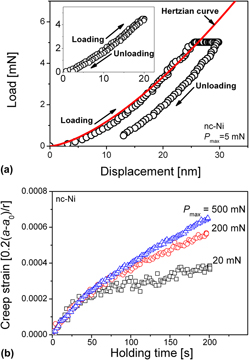Crossref Citations
This article has been cited by the following publications. This list is generated based on data provided by
Crossref.
Peykov, Daniel
Martin, Etienne
Chromik, Richard R.
Gauvin, Raynald
and
Trudeau, Michel
2012.
Evaluation of strain rate sensitivity by constant load nanoindentation.
Journal of Materials Science,
Vol. 47,
Issue. 20,
p.
7189.
Yang, Fuqian
and
Li, James C.M.
2013.
Impression test—A review.
Materials Science and Engineering: R: Reports,
Vol. 74,
Issue. 8,
p.
233.
Choi, In-Chul
Kim, Yong-Jae
Wang, Y. Morris
Ramamurty, Upadrasta
and
Jang, Jae-il
2013.
Nanoindentation behavior of nanotwinned Cu: Influence of indenter angle on hardness, strain rate sensitivity and activation volume.
Acta Materialia,
Vol. 61,
Issue. 19,
p.
7313.
ARMSTRONG, R. W.
ELBAN, W. L.
and
WALLEY, S. M.
2013.
ELASTIC, PLASTIC, CRACKING ASPECTS OF THE HARDNESS OF MATERIALS.
International Journal of Modern Physics B,
Vol. 27,
Issue. 08,
p.
1330004.
Maier, Verena
Merle, Benoit
Göken, Mathias
and
Durst, Karsten
2013.
An improved long-term nanoindentation creep testing approach for studying the local deformation processes in nanocrystalline metals at room and elevated temperatures.
Journal of Materials Research,
Vol. 28,
Issue. 9,
p.
1177.
Choi, In-Chul
Kim, Yong-Jae
Seok, Moo-Young
Yoo, Byung-Gil
Kim, Ju-Young
Wang, Yinmin
and
Jang, Jae-il
2013.
Nanoscale room temperature creep of nanocrystalline nickel pillars at low stresses.
International Journal of Plasticity,
Vol. 41,
Issue. ,
p.
53.
Kim, Yong-Jae
Lee, Won Woo
Choi, In-Chul
Yoo, Byung-Gil
Han, Seung Min
Park, Hong-Gyu
Park, Won Il
and
Jang, Jae-il
2013.
Time-dependent nanoscale plasticity of ZnO nanorods.
Acta Materialia,
Vol. 61,
Issue. 19,
p.
7180.
Yoo, Byung-Gil
Choi, In-Chul
Kim, Yong-Jae
Ramamurty, Upadrasta
and
Jang, Jae-il
2013.
Room-temperature anelasticity and viscoplasticity of Cu–Zr bulk metallic glasses evaluated using nanoindentation.
Materials Science and Engineering: A,
Vol. 577,
Issue. ,
p.
101.
Ramamurty, Upadrasta
and
Jang, Jae-il
2014.
Nanoindentation for probing the mechanical behavior of molecular crystals–a review of the technique and how to use it.
CrystEngComm,
Vol. 16,
Issue. 1,
p.
12.
Ma, Y.
Ye, J.H.
Peng, G.J.
Wen, D.H.
and
Zhang, T.H.
2015.
Nanoindentation study of size effect on shear transformation zone size in a Ni–Nb metallic glass.
Materials Science and Engineering: A,
Vol. 627,
Issue. ,
p.
153.
Kim, Yong-Jae
Yun, Tae Gwang
Choi, In-Chul
Kim, Sungwoong
Park, Won Il
Han, Seung Min
and
Jang, Jae-il
2015.
Time-dependent mechanical-electrical coupled behavior in single crystal ZnO nanorods.
Scientific Reports,
Vol. 5,
Issue. 1,
Chuang, Shu-Fen
Lin, Shih-Yun
Wei, Pal-Jen
Han, Chang-Fu
Lin, Jen-Fin
and
Chang, Hsien-Chang
2015.
Characterization of the elastic and viscoelastic properties of dentin by a nanoindentation creep test.
Journal of Biomechanics,
Vol. 48,
Issue. 10,
p.
2155.
Ma, Y.
Ye, J.H.
Peng, G.J.
Wen, D.H.
and
Zhang, T.H.
2015.
Loading rate effect on the creep behavior of metallic glassy films and its correlation with the shear transformation zone.
Materials Science and Engineering: A,
Vol. 622,
Issue. ,
p.
76.
Kim, Yong-Jae
Choi, In-Chul
Lee, Jung-A
Seok, Moo-Young
and
Jang, Jae-il
2015.
Strain-dependent transition of time-dependent deformation mechanism in single-crystal ZnO evaluated by spherical nanoindentation.
Philosophical Magazine,
Vol. 95,
Issue. 16-18,
p.
1896.
Durst, Karsten
and
Maier, Verena
2015.
Dynamic nanoindentation testing for studying thermally activated processes from single to nanocrystalline metals.
Current Opinion in Solid State and Materials Science,
Vol. 19,
Issue. 6,
p.
340.
Ctvrtlik, Radim
Al-Haik, Marwan S.
and
Kulikovsky, Valeriy
2015.
Mechanical properties of amorphous silicon carbonitride thin films at elevated temperatures.
Journal of Materials Science,
Vol. 50,
Issue. 4,
p.
1553.
Rabemananjara, Liva
Hernot, Xavier
Mauvoisin, Gérard
Gavrus, Adinel
and
Collin, Jean-Marc
2015.
Formulation of a representative plastic strain and representative plastic strain rate by using a conical indentation on a rigid visco-plastic material.
Materials & Design,
Vol. 68,
Issue. ,
p.
207.
Ma, Y.
Peng, G.J.
Jiang, W.F.
Chen, H.
and
Zhang, T.H.
2016.
Nanoindentation study on shear transformation zone in a CuZrAl metallic glassy film with different thickness.
Journal of Non-Crystalline Solids,
Vol. 442,
Issue. ,
p.
67.
Lee, Jung-A
Seo, Brandon B.
Choi, In-Chul
Seok, Moo-Young
Zhao, Yakai
Jahed, Zeinab
Ramamurty, Upadrasta
Tsui, Ting Y.
and
Jang, Jae-il
2016.
Time-dependent nanoscale plasticity in nanocrystalline nickel rods and tubes.
Scripta Materialia,
Vol. 112,
Issue. ,
p.
79.
Storer, S. C.
Fitzpatrick, M. E.
Hainsworth, S. V.
and
Rist, M. A.
2016.
Experimental study of room-temperature indentation viscoplastic ‘creep’ in zirconium.
Philosophical Magazine,
Vol. 96,
Issue. 24,
p.
2547.
